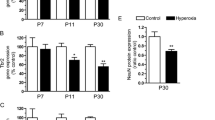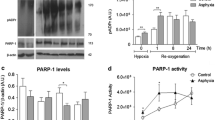Abstract
The issues of brain morphogenesis during the early postnatal period and the effect of perinatal hypoxia thereupon, which can lead to the development of neuropsychic pathology, are among the major medical and social challenges. It is well known that the nucleoli of neocortical neurons synthesize ribosomal subunits and are involved in various morphogenetic processes. When studying the effect of perinatal hypoxia on the developing brain in the model of neonatal encephalopathy, we revealed ultrastructural changes in the nucleoli of neocortical neurons and in the numerical ratio of their types, granular and reticulated. In control rats, as they developed in the neonatal period, there was an increase in the number of both granular and reticulated nucleolar types, which may be explained by a ribosomal RNA (rRNA) processing. By the end of the neonatal period, the granular agglomerates (ribosomal subunits) appeared near the nuclear membrane, probably be due to differentiation of nerve cells and biogenesis of the rough endoplasmic reticulum. In the present work, we established the fact of changing the numerical ratio of the granular and reticulated nucleolar types in the nuclei of neocortical neurons after perinatal hypoxic exposure in experimental vs. control rats. Our data suggest that the nucleoli in neocortical neurons are the targets for perinatal hypoxia, probably representing an intermediate link in the pathogenesis of the disease. Post-hypoxic administration of Phenibut (a GABA derivative, nootropic drug) corrected the pathogenetic effect of perinatal hypoxia by restoring the numerical ratio of the nucleolar types in neocortical neurons, which is typical of control rats. We assume that Phenibut can exert a neuroprotective effect through its ability to affect the nucleolar ultrastructure in neocortical neurons.




Similar content being viewed by others
REFERENCES
Dedov II, Smirnova OM, Gorelyshev AS (2012) Stress of endoplasmic reticulum: scenario of pathogenesis of human diseases. Problemy Endocrinologii 5:57–65 (In Russ).
Diaz HS, Andrade DC, Toledo C (2020) Inhhibicion of brainstem endoplasmic reticulum stress rescues cardiorespiratory disfunction in high output heart failure. Hypertension 14: 12016056. https://doi.org/10.1161/HYPERTENSIONAHA.120.16056
Osman A, El-Gamal H, Pasha M, Zeidan A, Korashy HM, Abdelsalam SS, Hasan M, Benameur T, Agouni A (2020) Endoplasmic reticulum (ER) stress- generated extracellural vesicles self-perpetuate ER stress and mediate endothelial cell disfunction independenly of cell survival. Front Cardiovasc Med 10 (7): 584791. https://doi.org/10.3389/fcvm.2020.584791
Hernandez-Verdun D, Roussel P, Thiry M, Sirri V, Lafontaine DLJ (2010) The nucleolus: structure/function relationship in RNA metabolism. Wiley Interdiscip Rev RNA 1 (3): 415–431. https://doi.org/10.1002/wrna.39
Németh A, Grummt I (2018) Dynamic regulation of nucleolar architecture Curr Opin Cell Biol 52:105–111. https://doi.org/10.1016/j.ceb.2018.02.013
Latonen L (2019) Phase-to-phase with nucleoli—stress responses, protein aggregation and novel roles of RNA. Front Cell Neurosci 13 (151): 1–10. https://doi.org/10.3389/fncel.2019.00151
Zimatkin SM, Zaerko AV, Fedina EM (2020) Nucleoli in devtloping histaminergic neurons of the rat brain Morphology 158(4-5): 7–13 (in Russ).
Otellin VA, Khozhai LI, Vataeva LA, Shishko TT (2011) Long-term effects of exposure to hypoxia in perinatal development on structural and functional characteristics of the brain in rats. Russ J Physiol 97(10):1092–1100 (In Russ).
Otellin VA, Khozhai LI, Vataeva LA (2012) Effect of hypoxia in early perinatal ontogenesis on behavior and structural characteristics of the rat brain. J Evol Biochem Physiol 48: 540–547.
Hernandez-Verdun D (2011) Structural organization of the nucleolus as a consequence of the dynamics of ribosome biogenesis. The nucleolus (in Protein Reviews) 15 (1): 3–28. https://doi.org/10.1007/978-1-4614-0514-6_1
Villacís L, Mei S, Ferguson L, Hein N, Amee G, Hannan K (2018) New Roles for the Nucleolus in Health and Disease. Rev Bioessays 40 (5): e1700233. https://doi.org/10.1002/bies.201700233
Otellin VA, Khozhai LI, Shishko TT, Tyurenkov IN (2016) Remote consequences of perinatal hypoxia and their posssible pharmacological correction: reactions of neocortical nerve cells and synapses. Morphlogy 150 (6):7–12 (In Russ).
Funding
This work was supported by the Russian Foundation for Basic Research (RFBR); grant no. 20-015-00052.
Author information
Authors and Affiliations
Contributions
Conceptualization and experimental design (V.A.O., L.I.Kh.); data collection (L.I.Kh., T.T.Sh.); data processing (V.A.O., E.A.V., T.T.Sh.); manuscript writing and editing (V.A.O.).
Corresponding author
Ethics declarations
COMPLIANCE WITH ETHICAL STANDARDS
All experimental procedures complied with the international Guidelines of Using Animals in Scientific Research and requirements of the EU Council Directive 1986 (86/609/EEC) on the use of laboratory animals. The protocols were approved by the Committee on the humane animal care at the Pavlov Institute of Physiology.
This study did not involve human subjects as research objects.
CONFLICT OF INTEREST
The authors declare that they have no conflict of interest related to the publication of this material.
Additional information
Translated by A. Polyanovsky
Russian Text © The Author(s), 2021, published in Zhurnal Evolyutsionnoi Biokhimii i Fiziologii, 2021, Vol. 57, No. 6, pp. 494–499https://doi.org/10.31857/S0044452921050065.
Rights and permissions
About this article
Cite this article
Otellin, V.A., Khozhai, L.I., Shishko, T.T. et al. Nucleolar Ultrastructure in Neurons of the Rat Neocortical Sensorimotor Area during the Neonatal Period after Perinatal Hypoxic Exposure and Its Pharmacological Correction. J Evol Biochem Phys 57, 1251–1256 (2021). https://doi.org/10.1134/S0022093021060053
Received:
Revised:
Accepted:
Published:
Issue Date:
DOI: https://doi.org/10.1134/S0022093021060053




